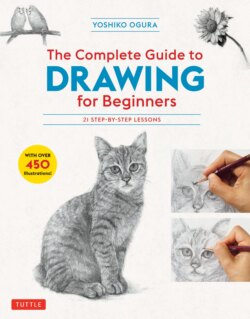Читать книгу The Complete Guide to Drawing for Beginners - Yoshiko Ogura - Страница 8
На сайте Литреса книга снята с продажи.
ОглавлениеTerms Used in Drawing
Axis A line passing through the center of a solid
object. In objects such as fruits and vegetables,
the axis runs through the core.
Backlight Light shining from behind the subject.
Base drawing The first layer of rough shading that
enables you to define the general shape and tonal varia-
tions before you begin to refine the drawing.
Brightness The degree to which light reflects from an
object’s surface.
Centerline A line that bisects a symmetrical object
being depicted. Alternatively, a line that divides the
horizontal or vertical halves of a composition.
Center point A point positioned in the center of the ob-
ject being depicted. Alternatively, a point in the middle
of the various elements of a composition.
Composing The act of mindfully positioning and
scaling an object or objects on the drawing surface. See
page 26.
Composition mark A lightly drawn mark to serve as
a guide for determining the position of an object at its
base, used before roughing in the preliminary sketch.
Contrast The observable difference in adjacent light
and dark areas of a drawing. Areas of high contrast
exhibit an intensity that draws the eye.
Depth The distance from the front to the back of the
object. Depth in drawings is often expressed by subtly
blurring and lightening the portions that should appear
farthest from the viewer.
Details Final, small, carefully made additions to a
drawing that make it come alive with realism.
Diagonal A line connecting the vertices of two non-ad-
jacent corners of a polygon. Also, for polyhedra, a line
segment connecting two vertices that are not on the
same plane.
Dominant Eye The eye that is used primarily for sight.
The non-dominant eye plays a supporting role in cor-
recting focus and comprehending depth perception. To
determine your dominant eye, hold an index finger out
while you focus on a distant object. Move your finger
to cover the distant object, and then close one eye at a
time. The eye that still sees the distant object as being
covered up is the dominant one.
Eye level The vantage point of the viewer. When dis-
cussing perspective, it refers to the level of the vanishing
point. See page 56.
Focus In drawing, it is the part of the image in the fore-
ground that commands attention and draws the eye.
Form The shape of an object or group of assembled
objects. See page 30.
Free-hand Drawing without the use of tools such as
a ruler or French curve. This book focuses on freehand
drawing instruction.
Golden ratio A ratio expressed as 1:1.618 in geometry,
which is the basis of the “golden rectangle,” an aesthet-
ically pleasing shape that has been used in many famous
artworks, such as Leonardo da Vinci’s “Mona Lisa.”
Gradation Gradual changes from one shade, color or
texture to another.
Highlight The location or locations on an object where
the most light is reflected to the viewer’s eye. If the
object is polished, the highlight will be sharply defined.
If the object is textured, the highlight will be diffuse.
Inherent color The actual color of the surface of a given
object, unrelated to the intensity of the lighting.
Intersection The vertex where the edge of two planes
of a three-dimensional shape meet. Understanding of
planes and vertices is the basis of drawing. See page 38.
Light source The natural or artificial point or points
from which light is directed toward an object. In draw-
ing, it is important to determine the light source, and
understand how it affects shading, highlights and shad-
ows. See page 8.
Low Angle Observing the object to be drawn from a
low vantage point.
Masking tape Low-tack painter’s tape useful for
recording the position of an object that is likely to be
moved before the drawing is completed.
Mass A sense of volume and weight achieved through
careful attention given to emulating an object’s obser-
vable characteristics.
Measuring stick Any thin rod used to visually measuring
an object. Most artists use their handy pencil to mea-
sure. See page 30.
Natural light Light from the sun.
Object The subject of your drawing.
Outline A line that represents the border between
objects and space. Outlines in the foreground tend to be
heavier and sharper, while outlines in the background
tend to be lighter and fuzzier.
8
